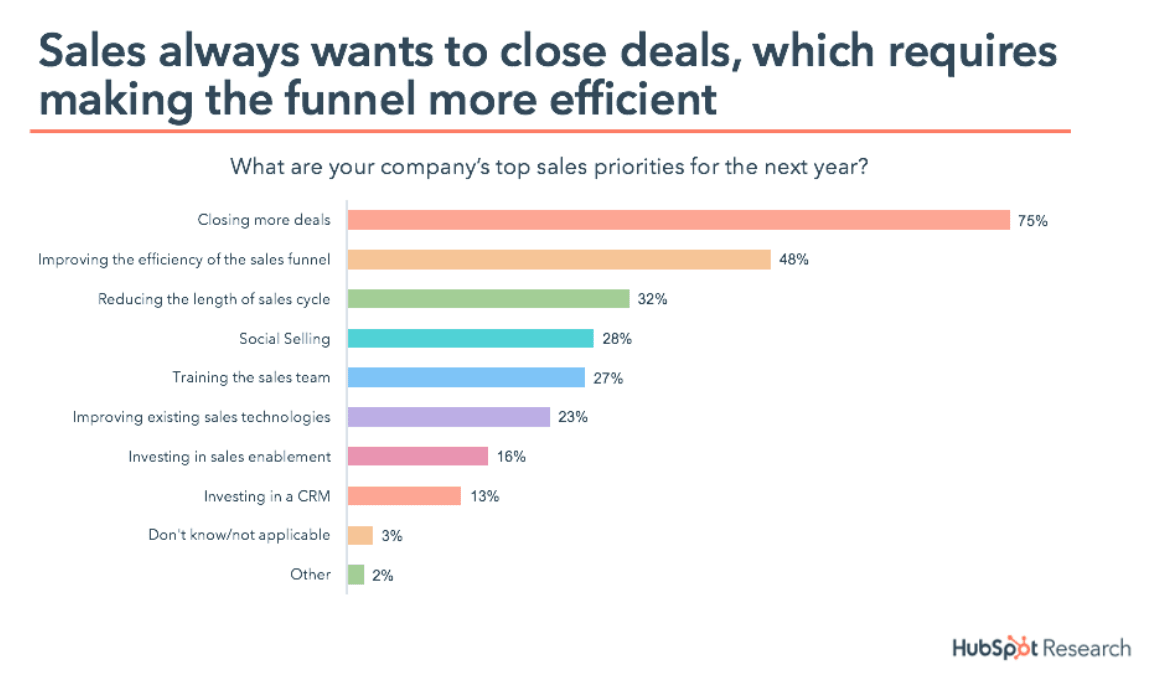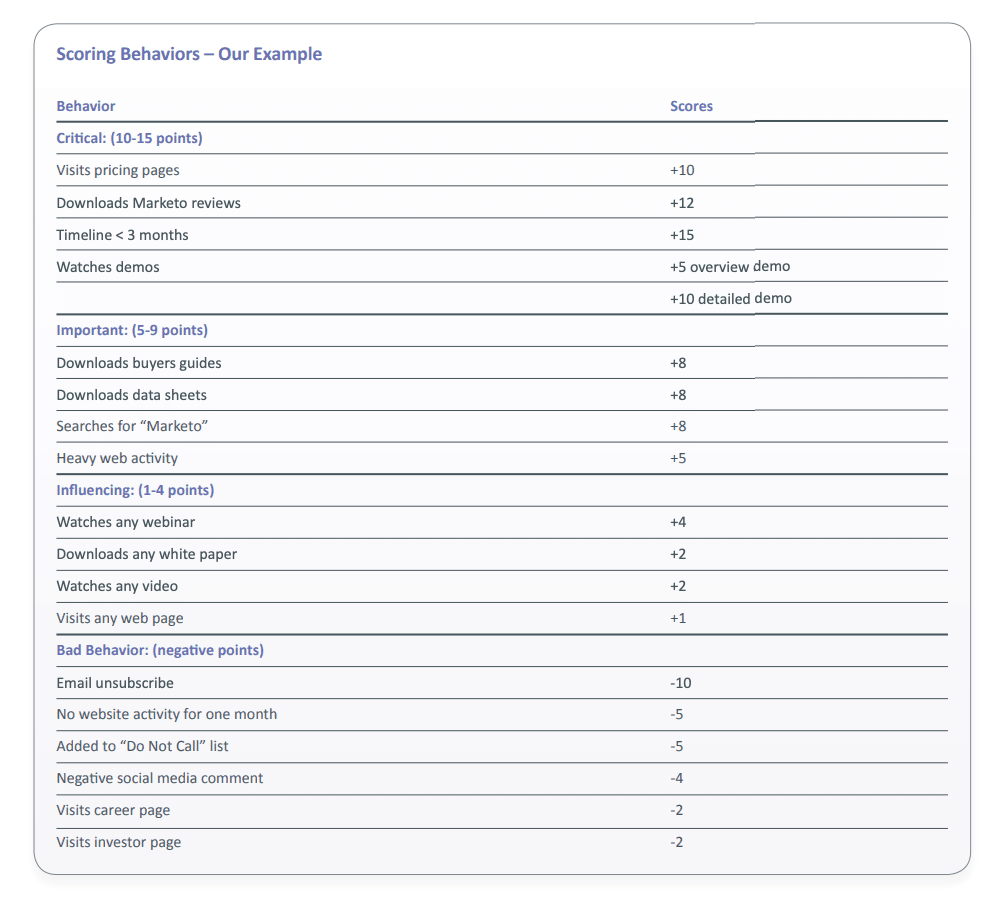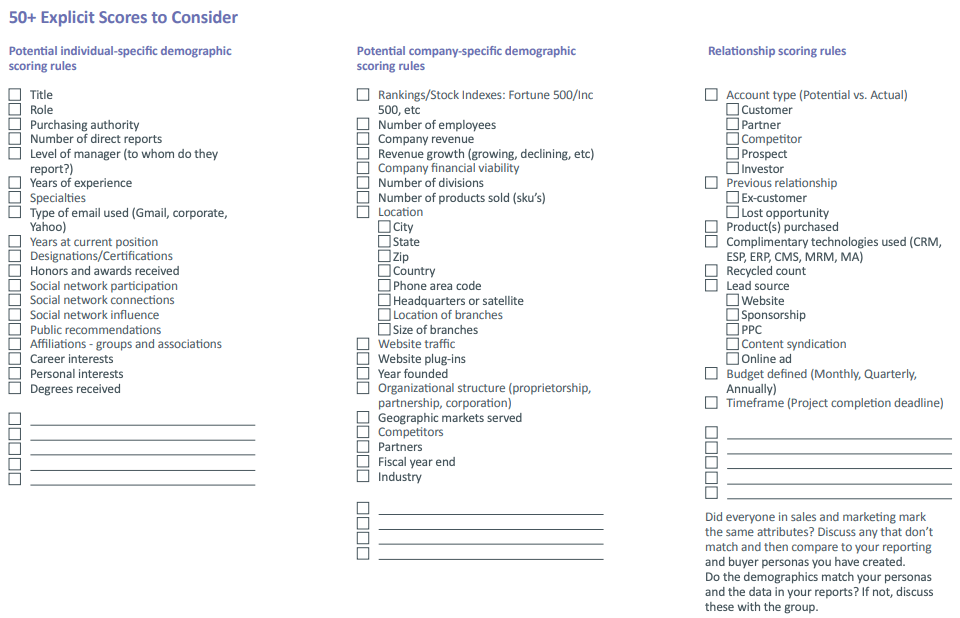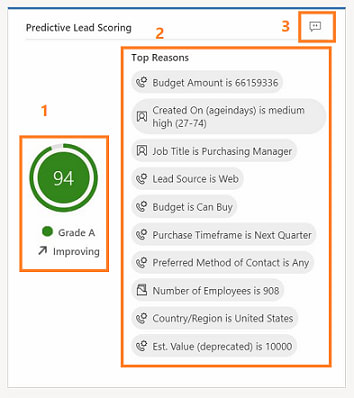According to the latest State of Inbound report by HubSpot, marketers’ top priority for the next 12 months is to convert more leads into customers. Meanwhile, the same report shows sales teams want to focus on closing more deals (75%) and improving the efficiency of the sales funnel (48%).

Lead qualification and scoring (Lead Q&S) is the first step to achieving these goals for marketing and sales teams. By grading your leads at various stages of the sales funnel and prioritising your marketing efforts on the most valuable prospects, you have a system in place that allows you to maximise conversions, efficiency, customer retention and – above all – profit.
In this guide to lead qualification and scoring, we’re going to show you how to implement this kind of system and achieve the top marketing and sales priorities for the year ahead.
Not all leads are created equal
With such a heavy emphasis on inbound marketing these days, it’s easy for teams to get caught up in the numbers game: traffic volumes, conversion rates, lead quantity, etc.
The problem is, not all leads are created equal.
Understanding lead quality
Some leads are far closer to making the purchase than others, meaning it should take less work to get them over the finishing line. While those who are further away from buying will need a different series of messages to nurture them towards the sale.
It takes very different marketing approaches to close both of these leads and you need a way to distinguish between them.
Naturally, the quality of leads is going to vary as they progress along your sales funnels. It’s important your marketing and sales teams are able to respond to these changes and deliver targeted messages, at each stage of the buying process, to nurture leads towards making the purchase.
Understanding lead value
You also need to consider how valuable each lead is expected to be to your business. A prospect who make a single low-value purchase is much less beneficial to you than someone who buys your most expensive product or a repeat customer who keeps coming back to complete more sales.
Once again, these different leads types are going to require different marketing approaches. However, it’s also a question of efficiency and deciding which leads to prioritise – especially if your sales team is swamped and needs to focus its attention on the most valuable leads.
In some cases, you might even decide certain leads simply aren’t worth pursuing. For example, you might be a digital agency that can only take on so many projects at a time and you need a system in place that accurately predicts the value of each lead so you can choose which projects to take on.
What is lead qualification?
Lead qualification is a method of measuring and/or predicting the quality and value of leads, based on the data you have about them and the way they interact with your brand.
Essentially, this starts with defining your criteria for qualifying leads, as well as your criteria for disqualifying them (this is just as important).
To create an integrated marketing and sales with lead qualification, you’ll need to understand the difference between marketing qualified leads (MQLs) and sales qualified leads (SQLs).
- MQL: A marketing qualified lead is one that’s engaged with your brand through one of your inbound channels – your website, social media, PPC ad, etc. They’ve shown value as a lead (hence qualified) but they haven’t proven they’re sales ready yet.
- SQL: Sales qualified leads have progressed further along the buying process and taken certain actions you’ve defined as making them sales-ready. This is where your sales team steps in to close the deal.
The criteria for MQLs and SQLs are very different. With marketing qualified leads, your primary goal is to determine which leads have genuine purchase intent because not everyone who downloads your e-book is planning to buy from you.
Once you’ve established purchase intent, you want to pinpoint where they are along the sales funnel and start your lead nurturing campaigns. Keep these leads engaged with your brand and guide them towards taking actions that turn them into SQLs.
Then it’s over to your sales processes to do the rest.
For a more comprehensive look at these two types of lead qualification, check out our guide on MQLs vs SQLs.
What is lead scoring?
Lead scoring allows you to assign a value to each lead, based on various criteria. These scores can change as leads progress along the buying process, making it easier for your marketing and sales teams to prioritise leads at each stage of the sales funnel
Here’s a handy video from HubSpot for more info.
There are two basic key types of lead scoring you need to know about: implicit leads scoring and explicit lead scoring.
- Implicit lead scoring: Generally involves scoring leads based on user behaviours – the pages they visit on your site, actions they take and interests they show.
- Explicit lead scoring: Matches prospects to your buyer profiles by comparing demographic data and other information you collect from users, normally through online forms.
Implicit lead scoring uses accessible data from user sessions without people actively handing over information. You’ll get this from your analytics tools, cookies, tracking URLs, events tracking and other tools.
Explicit lead scoring, on the other hand, uses data you collect from users, which requires them to engage with your brand more deeply. Explicit lead scoring is also generally more reliable than implicit – for example, getting users to confirm their location rather than using their IP address.
Why are lead qualification and scoring important?
Research has shown that companies with an effective lead qualifying and scoring process achieve a 70% increase in lead generation ROI.
A separate study from Gartner found 70% of leads are lost due to poor follow-ups from brands.
According to research by @Gartner, 70% of #leads are lost from poor follow-up. Don't let people slip through the cracks!
Thanks @abstraktmg for the cool #infographic! #leadgeneration #CRM #salestips #business #smallbusiness #biztips #sales #salestips #analytic #technology pic.twitter.com/G1LZou2ZtW
— Agile CRM (@agilecrm) May 6, 2018
If that’s not enough to confirm why lead qualification and scoring is so important, here are some bullet points to hammer home the message:
- Lead Q&S helps you prioritise which leads are most valuable to your brand.
- It also helps you increase the quality of less valuable leads by identifying what kind of marketing messages they respond to.
- Lead Q&S unites the marketing and sales processes, showing each team when they need to step in.
- The flip side of this is you stop wasting time, money and other resources on leads that have no sales potential.
- This increases conversion rates, drives down your cost-per-sale, increases ROI and boosts just about every profit-related KPI across your sales and marketing strategies.
- An advanced lead Q&S system allows you to deliver highly targeted messages to users progress through the buying process.
- You can use this kind of system to test and optimise new messages, create a more efficient sales funnel and use your insights to convert more leads into customers.
- With a mature lead Q&S system in place, you’ll eventually be able to predict the long-term potential value of leads, based on your historical data.
Essentially, it all comes down to creating a more efficient and profitable sales process at every stage of the consumer journey. In terms of maximising your marketing and sales ROI, lead qualification and scoring should be the first system you put in place.
Putting lead Q&S into action
Hopefully, you now understand the importance of lead qualification and scoring, understand what the two processes mean and have a hunger to implement them into your business.
Now, we need to turn our attention to putting lead Q&S into action.
Let’s start by looking at some of the basic principles of lead qualification and scoring.
Basic principles of lead qualification
In this section, we’re going to look at the following principles of lead qualification:
- Organisation-level qualification
- Opportunity-level qualification
- Stakeholder-level qualification
- The BANT, MEDDIC and CHAMP qualification frameworks
- Disqualifying leads
This will give you a more in-depth understanding of what lead qualification involves at the practical level and enough theory to implement your own system.
So let’s crack on.
Organisation-level lead qualification
This is the most basic application of lead qualification, essentially telling you whether a lead is worth actively pursuing or not. At this stage, you’re simply checking whether a prospect matches the basic organisational (or personal for B2C) characteristics of your target customers.
The kind of questions you want to answer at this stage might include:
- Is this prospect in a location you can sell to?
- Are they in an industry you sell to?
- Are your products relevant to their needs, services or customers?
- What size is this company?
- Do they match any of your buyer personas?
If a lead fails to qualify at the organisational level, you have a strong indication it’s not worth pursuing with at all. Move on and focus your efforts on prospects that have a genuine potential of buying from you in the near future or further down the road.
Opportunity-level lead qualification
Next, we have opportunity-level lead qualification and this is where you really start to assess the quality of your prospects.
Potential questions to answer here include:
- What problem does this prospect have that you can solve?
- What kind of budget do they have to work with?
- How much profit are you going to get from solving this problem for them?
- What’s it going to cost you to convert this lead into a customer?
- What’s the potential lifetime customer value of this prospect?
By answering these questions, you’ll be able to prioritise which leads have the most potential and adapt your follow-up messages to suit.
Opportunity-level qualification will also improve your lead segmentation and nurturing efforts, which you can use to guide users along the path to purchase.
Stakeholder-level lead qualification
This is really important for B2B marketing because you need to know the leads you’re dealing with actually have the authority/ability to make the purchase. The last thing you want to do is spend valuable resources on nurturing a prospect who can’t influence buying decisions at their company.
Prospects who are decision-makers at their company are always the most valuable from a B2B perspective.
This doesn’t mean you should only target CEOs and other executives, though. Instead, you should identify which positions you expect to have power of influence when it comes to buying your products/services.
This depends on what you’re selling as much as who you’re targeting.
Questions to answer at this point can include:
- Does this prospect make the purchase decision?
- Can this prospect influence the purchase decision, even if the final call isn’t theirs?
- What position does this prospect hold at the company?
- Which department do they work in?
- Does their department have its own budget and authority to make purchase decisions?
- Who else makes the purchase decision, if not this prospect?
Prospects who pass all three levels of qualification should be picked up by your sales team.
Leads that don’t qualify at the stakeholder-level can still be valuable if they’ve qualified at previous levels. The key is to automate follow-ups and lead nurturing strategies for prospects that don’t qualify at this level or those you’re unable to collect the necessary information from.
You don’t really have anything to lose by keeping prospects on your automated marketing/sales processes but you do have a lot to gain by prioritising the leads you know have the ability to make the purchase.
The BANT qualification framework
BANT is one of the most widely-used frameworks for qualifying leads. Originally developed by IBM, the BANT framework comprises of four key attributes B2B leads should demonstrate in order to be qualified:
- Budget: Can the prospect afford what you’re selling?
- Authority: Does the prospect have authority to complete the purchase?
- Need: Does the prospect have a genuine need/desire for what you’re selling?
- Timeline: When is the prospect likely to buy?
This is a framework you’ll come across a lot when you’re looking into lead qualification and it’s important to understand its strengths and weaknesses.
First of all, BANT only really applies to the opportunity level and even here it has its limitations. For example, attributing purchase authority to a single prospect is short-sighted when research shows it takes an average of 5.4 people to make B2B buying decisions.
The timeline element can also be problematic in today’s marketing environment where we have the capabilities of nurturing leads over the course of months or even years.
Despite these shortcomings, BANT is a useful framework to understand and apply it to your opportunity-level qualification, as long as you don’t implement it too strictly.
Basic principles of lead scoring
In this section, we’re going to look at the following principles of lead scoring:
- Implicit lead scoring
- Explicit lead scoring
- Demographic lead scoring
- Organisational lead scoring
- Behavioural lead scoring
- Product/account lead scoring
- Predictive lead scoring
Again, this will give you a more in-depth understanding of what the process involves, how it works alongside lead qualification and equip you with the knowledge you need to implement your first lead Q&S system.
Implicit lead scoring
As we mentioned earlier, implicit lead scoring is based on the user data accessible to you without prospects having to actively provide information. So this is where you’re going to use technologies like analytics, cookies, IP locations, URL tracking and everything else at your disposal to score leads using people’s online footprint.
The first thing you need to do is pinpoint which data enables you to measure and score purchase intent.
In most cases, implicit lead scoring revolves around online actions/behaviours, but this isn’t always the case (e.g.: IP location). So, aside from picking the right data points, you also need to understand what they represent.
For example:
- A single visit to one of your product pages suggests potential interest.
- Multiple visits to the same product page suggest a strong interest.
- Searches including your brand’s name suggest people have heard about you elsewhere and wanted to find out more about you (maybe they saw your content on social media, your ad in Google Search or read about you in a blog post).
- A user watching your product demo suggests they have a relatively strong interest in that product category.
- A content download indicates an interest in the topic covered.
That’s just a few examples of multiple different actions that each represents a unique user intent. You’re not simply going to look at individual actions, though. You’re going to track user behaviour on your website and build a profile that allows you to score them as a lead based on multiple data points.

Here’s an example of an implicit lead scoring dataset from Marketo. This gives you an idea of what kind of data sets you want to be cross-referencing to calculate your implicit lead scores.
Explicit lead scoring
For explicit lead scoring, you need to get data from users – normally by encouraging them to fill out web forms. This kind of data is generally considered to be more robust than implicit data because analytics, cookies and URL tracking can run into problems, particularly when people move between devices.
That said, this principle relies on the assumption users fill out their details correctly and honestly.
Crucially, explicit lead scoring should give you access to more valuable data – things like user email addresses, job titles and other pieces of information you can’t get access through implicitly.

Here’s another example from Marketo to give you an idea of the kind of data points you might want to focus on.
Implicit lead scoring helps you score leads at the very early stages of the buying process but it’s explicit lead scoring that’s going to help you really pinpoint those most valuable leads at the latter stages of the sales funnel.
Demographic lead scoring
As you can probably guess, demographic lead scoring values prospects based on characteristics – their age, where they live, what they do for a living and anything else you identify as being important.
Essentially, this process measures how closely leads match your buyer personas.
You should have multiple buyer personas mapped out, which allows you to target them more effectively and deliver more relevant messages. Not all of these personas are going to be equally as valuable to your brand, specific products/services or individual marketing campaigns.
So you want to assign scores to these buyer personas and then match new leads to the most relevant persona.
Organisational lead scoring
For B2B brands, targeting individuals isn’t enough. You also need to target organisations (and individuals at specific types of organisation).
Marketing software providers, for example, have probably got one of the most diverse ranges of customers to work with. After all, every brand needs a solid marketing strategy and the right tools to implement it.
Even still, organisations in certain industries, of certain sizes and in certain locations (among other things) are going to be more profitable to you.
Certain industries tend to command more marketing budget than others and larger businesses generally have more to spend in this area, too. Likewise, brands in other industries might be deemed higher risk than others – for example, a payday loan company that’s often more likely to have their ads declined or end up on the wrong side of a search algorithm update.
We use a lead form to pre-qualify our leads as they complete our web forms. With forms designed around the principle of conditional logic, we’re able to ask users relevant questions and their answers determine which questions they’ll be asked next.
This allows us to find out how much budget a prospect has to work with, what kind of service they need from us, how urgent their project is and all kinds of other questions. Above all, we can use this information to qualify leads and prioritise those that offer the most value to us. But we can also use this data to create relevant follow-up messages, based on their individual needs, which increases the likelihood of them turning into genuine customers.
Best of all, we can automate this so prospects get a response almost instantly, thus keeping them engaged.
Considering leads turn cold in roughly 24 hours, this automated lead qualification and response system is crucial for us.
Behavioural lead scoring
Now we’re getting to a more advanced type of lead scoring, where you assess the online behaviour of your prospects and use this to determine their value. This relies entirely on your ability to accurately and reliably track user actions as they interact with your brand across multiple sessions and devices.
However, you also need to understand what behavioural actions mean in terms of lead value.
For example, someone who looks at the same product page multiple times across different user sessions shows a stronger purchase intent than someone who only views this page once. Likewise, a user who compares multiple similar products and then reads one of your blogs on the best [product category] to buy in 2019 probably needs some help with making a purchase decision.
There are all kinds of subtle nuances you can take away from user actions and the precise meaning can vary a great deal once you start looking at combined actions.
With site tracking in ActiveCampaign, we can track user actions on our website and then automate our marketing responses.
During those early sessions, you’re going to rely on cookies and user IDs to track user behaviours. This will tell you which products/services each lead is interested in, how strong their interest is and how close they are to making the purchase.
As good as these technologies are now, cookies and tracking IDs aren’t 100% reliable and you’ll want to get your hands on prospects’ email addresses as soon as possible.
Product & account lead scoring
Product scoring is where you assign a score to specific products or services so the most profitable/worthwhile products or services are prioritised. So, when all else is equal, prospects who show an interest in the highest scoring products or services will have a higher overall lead score.
Product scoring should only ever be a factor that’s considered in the overall scoring of your leads, though. Don’t make the mistake of prioritising leads purely on the product or service they’re interested in – because there are other factors to consider.
For example, a customer who makes repeated low-value purchases might be more valuable to you than a customer who makes a one-off high-value purchase.
This brings us on to account scoring, where your aim is to assign a value to the long-term potential for each prospect. The most basic approach to this is to assign scores to existing customers, based on the products they’ve already bought.
The easiest example would be a customer who repeatedly buys the same product or spends a similar amount at regular intervals – e.g.: a software subscriber or a company that spends £10,000 per month on stock products from you.
This gives you a relatively accurate idea of the ongoing value this customer has for you.
However, you can use something called predictive lead scoring to calculate the long-term value of prospects before they even buy the first product. This technology relies on AI and machine learning to match user behaviours to future purchase decisions.

There’s an example of what predictive lead scoring looks like in Microsoft Dynamics 365 and it gives you a good idea of how the technology works. The great thing about predictive lead scoring is it’s able to calculate from a large number of interactions – far more than any human team of creatives will be capable of doing.
Of course, the question of reliability still hangs over this relatively new technology but things are advancing rapidly in this area. It won’t be long before rpedictive lead scoring is the norm for businesses of all sizes.
Make lead qualification & scoring priorities
Every efficient marketing strategy employs effective lead qualification and scoring – otherwise, you simply can’t distinguish between the prospects that matter most to your brand and the ones that are going to waste your marketing resources.
Prioritisation isn’t the only role lead qualification plays in your marketing strategy, though. The more accurately, you’re able to gauge the value and purchase intent of each prospect, the more relevant and effective your marketing messages are going to be to their needs as they change along the buying process.




